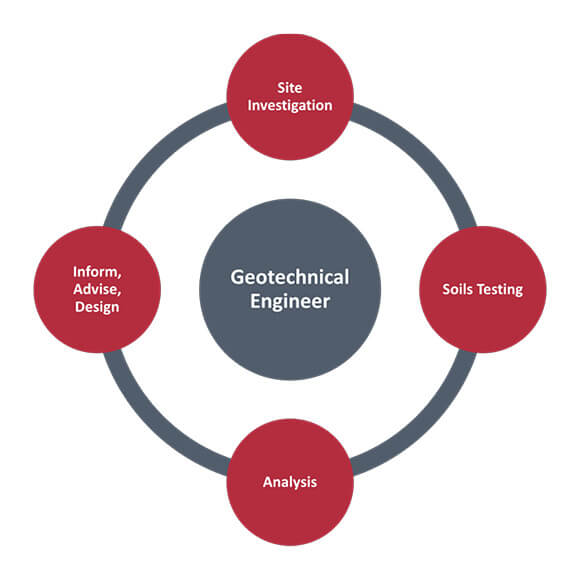The Buzz on Geotheta
The Buzz on Geotheta
Blog Article
Indicators on Geotheta You Need To Know
Table of Contents5 Simple Techniques For GeothetaUnknown Facts About GeothetaExamine This Report about GeothetaGeotheta for Dummies6 Easy Facts About Geotheta Shown

They perform website examinations, collect samples, execute research laboratory tests, and analyze information to evaluate the suitability of the ground for construction projects - Consulting Engineers. Based upon their findings, geotechnical engineers give referrals for foundation design, slope stability, maintaining structures, and mitigation of geotechnical risks. They team up with various other professionals, such as designers, architectural engineers, and building and construction groups, to guarantee that geotechnical factors to consider are incorporated right into the general project design and execution
By evaluating the habits and homes of dirt and rock, they can recognize possible geotechnical threats such as landslides, dirt settlement, or incline instability. Their knowledge assists prevent failures or crashes that could threaten lives and home. Right here are some comprehensive obligations and obligations of a geotechnical engineer: Site Investigation: Geotechnical designers conduct website examinations to gather data on subsurface problems.
They analyze the information to comprehend the properties and habits of the dirt and rock, including their strength, leaks in the structure, compaction features, and groundwater conditions. Geotechnical Evaluation and Style: Geotechnical designers evaluate the data accumulated throughout site investigations to analyze the security and viability of the website for building and construction tasks. They execute geotechnical computations and modeling to evaluate aspects such as birthing capability, negotiation, slope security, side planet pressures, and groundwater flow.
Indicators on Geotheta You Should Know
Foundation Layout: Geotechnical engineers play an important duty in designing structures that can safely sustain the designated framework. They evaluate the dirt conditions and load needs to figure out the suitable structure kind, such as shallow foundations (e.g., footings), deep foundations (e.g (https://www.dreamstime.com/ianhammond2191_info)., piles), or specialized methods like soil improvement. They think about factors such as negotiation restrictions, bearing capability, and soil-structure communication to create ideal structure designs
They assess building strategies, display website activities, and perform area assessments to verify that the design referrals are adhered to. If unpredicted geotechnical problems occur, they assess the scenario and give suggestions for remediation or modifications to the style. Threat Evaluation and Reduction: Geotechnical engineers assess geotechnical threats and dangers connected with the task website, such as landslides, liquefaction, or dirt erosion.

Collaboration and Interaction: Geotechnical engineers see post work closely with various other specialists associated with a project, such as designers, structural designers, and building and construction teams. Effective interaction and partnership are vital to incorporate geotechnical factors to consider into the overall task style and building and construction procedure. Geotechnical designers provide technological experience, response questions, and guarantee that geotechnical needs are satisfied.
Getting My Geotheta To Work
Below are some kinds of geotechnical engineers: Structure Designer: Foundation engineers focus on making and evaluating structures for frameworks. They evaluate the soil conditions, tons demands, and website attributes to determine the most proper foundation type and style, such as superficial structures, deep structures, or specialized strategies like pile foundations.
They assess the aspects affecting incline stability, such as soil homes, groundwater problems, and incline geometry, and establish methods to avoid incline failings and minimize threats. Quake Engineer: Quake designers focus on assessing and making frameworks to withstand seismic pressures. They assess the seismic risk of a site, examine soil liquefaction capacity, and develop seismic style requirements to guarantee the safety and security and resilience of frameworks throughout earthquakes.
They execute field testing, collect examples, and examine the collected information to identify the dirt residential properties, geologic formations, and groundwater conditions at a website. Geotechnical Instrumentation Designer: Geotechnical instrumentation engineers focus on tracking and determining the habits of soil, rock, and structures. They set up and preserve instrumentation systems that keep an eye on aspects such as soil settlement, groundwater degrees, incline motions, and structural variations to evaluate performance and supply early cautions of prospective issues.
Geotheta Can Be Fun For Everyone
They conduct examinations such as triaxial tests, combination examinations, direct shear tests, and leaks in the structure tests to collect data for geotechnical analysis and layout. Geosynthetics Engineer: Geosynthetics engineers concentrate on the design and application of geosynthetic materials, such as geotextiles, geogrids, and geomembranes. They make use of these materials to improve dirt stability, enhance slopes, supply drainage options, and control erosion.
They often tend to be investigative individuals, which implies they're intellectual, reflective, and curious. They wonder, systematic, logical, analytical, and sensible. Several of them are also social, indicating they're kind, charitable, cooperative, individual, caring, handy, understanding, sensible, and friendly. Does this seem like you? Take our totally free occupation examination to find out if geotechnical engineer is one of your top occupation suits.
In the workplace setting, geotechnical designers use specialized software application devices to perform calculations, develop layouts, and evaluate information. They prepare records, evaluation project specifications, communicate with customers and staff member, and coordinate job activities. The office setup supplies a favorable atmosphere for research study, analysis, and partnership with various other experts associated with the job.
How Geotheta can Save You Time, Stress, and Money.
They often go to project websites to carry out site examinations, assess geotechnical conditions, and gather data for evaluation. These gos to include traveling to different areas, often in remote or challenging terrains. Geotechnical designers might do dirt sampling, conduct examinations, and display building tasks to guarantee that the geotechnical facets of the project are being carried out correctly.
Geotechnical designers also function in specialized geotechnical laboratories. Geotechnical research laboratory engineers work extensively in these atmospheres, taking care of screening equipment, operating instruments, and videotaping information.
Report this page